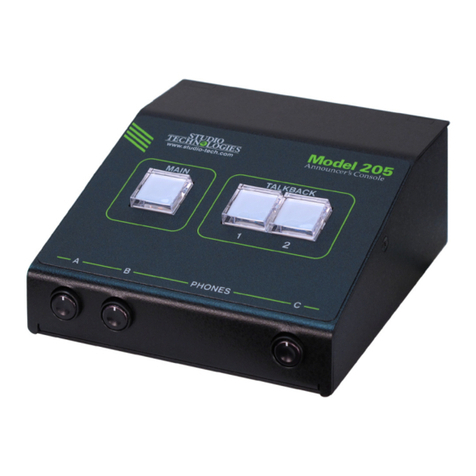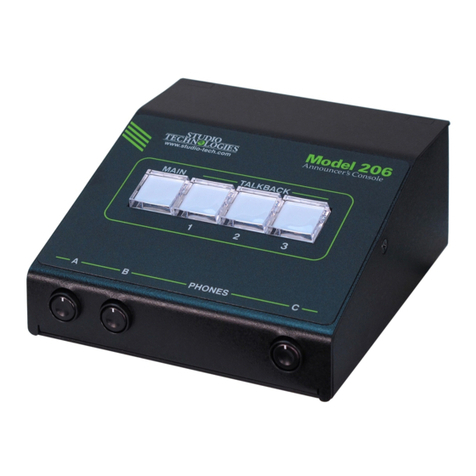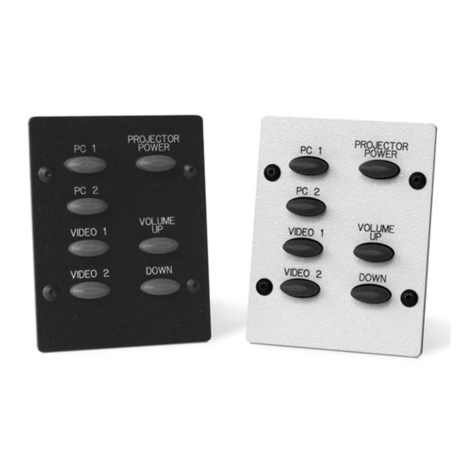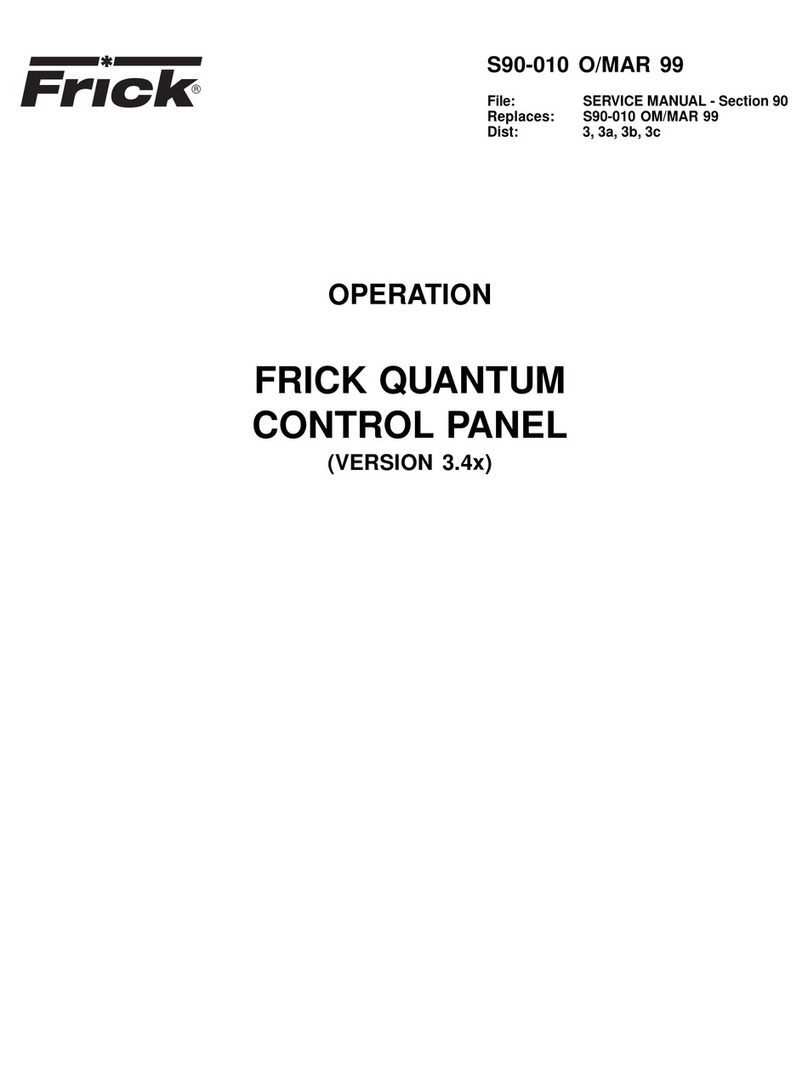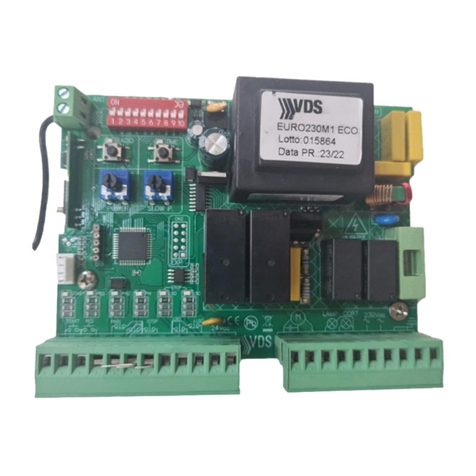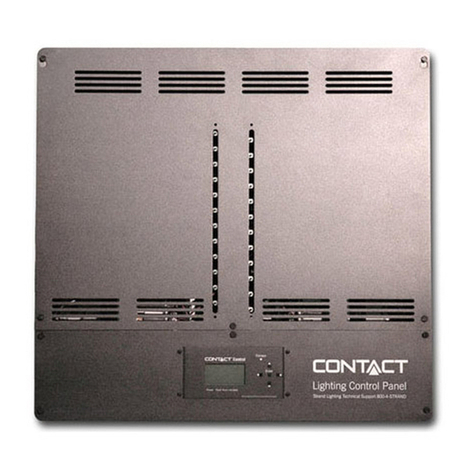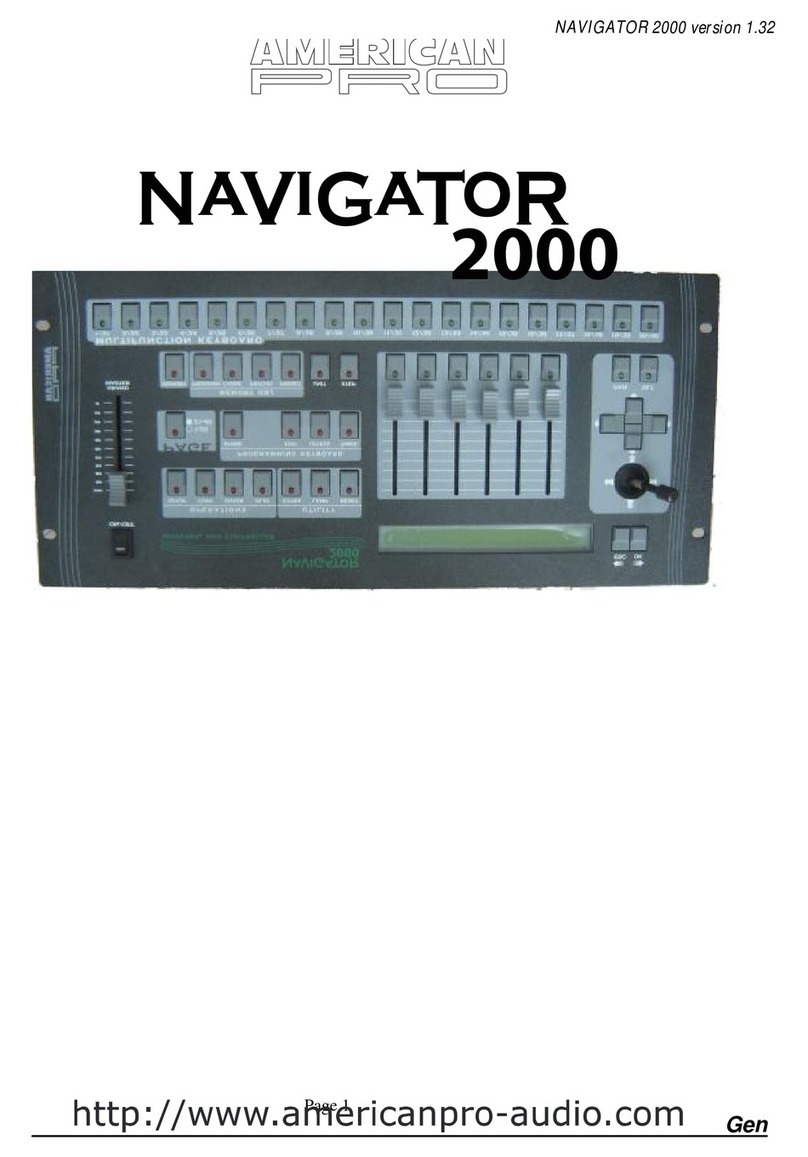Studio Technologies 204 User manual

Copyright © 2020 by Studio Technologies, Inc., all rights reserved
www.studio-tech.com
User Guide
Issue 3, August 2020
This User Guide is applicable for serial numbers
M204-00501 and later with application firmware 1.4 and later
and STcontroller application version 2.04.00 and later.
50639-0820, Issue 3
Model 204 Announcer’s Console

This page intentionally left blank.

Model 204 User Guide Issue 3, August 2020
Studio Technologies, Inc. Page 3
MODEL 204
ANNOUNCER’S CONSOLE
Table of Contents
Revision History ........................................................... 4
Introduction ................................................................... 5
Getting Started ............................................................. 10
Operation ...................................................................... 19
Technical Notes ............................................................ 24
Specifications ............................................................... 28
Appendix A: Model 204 Block Diagram ........................ 29

Issue 3, August 2020 Model 204 User Guide
Page 4 Studio Technologies, Inc.
MODEL 204
ANNOUNCER’S CONSOLE
Revision History
Issue 3, August 2020:
• Documents addition of Main Out Tally function. (Applies only to serial numbers
M204-00501 and later.)
Issue 2, October 2018:
• Documents addition of the Push to Mute/Tap to Latch main button operating mode.
Issue 1, May 2018:
• Initial release.

Model 204 User Guide Issue 3, August 2020
Studio Technologies, Inc. Page 5
MODEL 204
ANNOUNCER’S CONSOLE
Introduction
The Model 204 Announcer’s Console offers
a unique combination of analog and digital
audio resources for use in broadcast sports,
eSports, live event, entertainment, and
streaming broadcast applications. The unit is
housed in a compact, rugged steel enclosure
that’s intended for table-top use. Calling the
Model 204 “cute” or “cool” would be accurate;
its nicely proportioned but diminutive size
makes it ideal for use in space-constrained
locations. The Model 204 supports Dante®
audio-over-Ethernet digital media technol-
ogy with AES67 compatibility for integration
into contemporary applications. The unit is
extremely simple to deploy, is “pro” quality
throughout, and provides an intuitive user
experience. The Model 204’s audio quality is
excellent, with low distortion, low noise, and
ample headroom. Careful circuit design and
rugged components ensure long, reliable
operation.
The Model 204 integrates directly into both
Dante audio-over-Ethernet and standard
analog audio environments. With just a
Power-over-Ethernet (PoE) connection, a
microphone, and a pair of headphones or an
earpiece, a complete broadcast on-air posi-
tion can be created. And by using the Model
204’s microphone output a direct connection
to an analog microphone-level input on an
associated camera, remote I/O interface,
or audio console can be supported. Two
remote control inputs allow external switches
or contact closures to activate the main and
talkback button functions. One of the inputs
can also be configured to provide a low-
voltage DC “tally” output that follows the
state of the main output.
Model 204 operating features are configured
using the STcontroller software application.
An extensive set of parameters allows the
unit’s functions to be tailored to meet the
needs of many applications. STcontroller is
a fast and simple means of confirming and
revising the unit’s operating parameters.
Applications
The Model 204 on its own can provide an
“all-Dante” solution for one on-air talent
location. A wide range of applications can
be supported, including sports and enter-
tainment TV and radio events, streaming
broadcasts, corporate and government AV
installations, and post-production facili-
ties. The unit’s small size makes it ideal for
live-sports applications, such as basketball,
where physical space for personnel is very
limited. Four Dante receiver (audio input)
channels supply the user with their talent
cue (IFB) signals. Should the cue signal be
“mix-minus” an integrated sidetone function
Figure 1. Model 204 Announcer’s Console front
and rear views

Issue 3, August 2020 Model 204 User Guide
Page 6 Studio Technologies, Inc.
MODEL 204
ANNOUNCER’S CONSOLE
can provide the user with a microphone
confidence signal. Two Dante audio output
channels, one designated as main and the
other as talkback, are routed via an associ-
ated local-area network (LAN) to inputs on
Dante-compatible devices. Two pushbutton
switches, main and talkback, provide the
user with direct control over audio routing.
The audio switching is performed in the
digital domain and is virtually “click-free.”
By providing the main audio signal in two
forms, Dante digital audio and analog
microphone level, the Model 204 makes
integration into a wide range of on-air envi-
ronments easy to accomplish. The talkback
audio channel is available as a Dante out-
put channel which makes routing to an input
on a variety of devices, such as matrix inter-
com systems, audio consoles, and monitor
loudspeaker systems, simple and flexible.
Some applications may benefit from not
utilizing the Model 204’s Dante main output
channel. This typically won’t be an issue
of inadequate audio quality but rather a
need to match work-flow requirements. For
example, for lip-sync or transmission pur-
poses it may be optimal to have the on-air
audio transported as an embedded signal
along with the associated camera video. Al-
ternately, all on-air audio sources may need
to connect to inputs on an audio console or
console-related I/O unit. Supporting these
scenarios is not a problem as the Model
204 supplies a microphone output connec-
tion that’s specifically intended for this pur-
pose. Simply connect the unit’s microphone
output connection to the desired analog
input, such as the mic/line input on an ENG-
style camera—that’s it!
The circuitry associated with the Model
204’s analog microphone output is very sim-
ple, essentially a passive path that routes
a signal connected to the microphone input
connector directly to the microphone output
connector. A solid-state circuit, in series with
the mic in-to-mic out path, allows muting of
the signal on the microphone output con-
nector whenever the Dante main output
channel is muted. Having both the Dante
main output and the microphone outputs
work in tandem can be a valuable resource,
allowing one to serve as the primary on-air
signal source while the other serves as the
backup.
Setup and Operation
Set up, configuration, and operation of the
Model 204 is simple. An etherCON® RJ45
jack is used to interconnect with a standard
twisted-pair Ethernet port associated with a
PoE-enabled network switch. This connec-
tion provides both power and bidirectional
digital audio. A broadcast headset or hand-
held (“stick”) microphone can be directly
connected to the unit’s 3-pin XLR mic input
connector. The input is compatible with dy-
namic or condenser microphones. The inte-
grated P48 phantom power source provides
support for a wide range of condenser mi-
crophones. A 3-pin XLR microphone output
connector provides a “direct mic out” func-
tion for integration with microphone inputs
on related devices. Stereo headphones,
the headphone connections from a stereo
or monaural headset, or even a monaural
earpiece can be connected to the phones
output jack.
External switches or contact closures can
be connected to the Model 204’s remote
control inputs to allow activation of the
main and talkback button functions. A low-
voltage/low-current DC output can also be
implemented providing a Main Out Tally
function. The STcontroller software applica-
tion is used to configure the wide range of

Model 204 User Guide Issue 3, August 2020
Studio Technologies, Inc. Page 7
MODEL 204
ANNOUNCER’S CONSOLE
Model 204 operating parameters. This al-
lows the unit’s performance to be optimized
to meet the needs of specific applications.
The user is presented with two pushbutton
switches and three push-in/push-out rotary
level potentiometers. This makes it easy to
control the status of the main and talkback
outputs as well as adjusting the signals that
are sent to the headphone channels.
Ethernet Data and PoE
The Model 204 connects to a local area net-
work (LAN) by way of a standard 100 Mb/s
twisted-pair Ethernet interface. The physical
100BASE-TX interconnection is made by
way of a Neutrik® etherCON RJ45 connec-
tor. While compatible with standard RJ45
plugs, etherCON allows a ruggedized and
locking interconnection for harsh or high-
reliability environments.
The Model 204’s operating power is pro-
vided by way of the Ethernet interface using
the 802.3af Power-over-Ethernet (PoE)
standard. This allows fast and efficient inter-
connection with the associated data net-
work. To support PoE power management,
the Model 204’s PoE interface enumerates
(reports) to the power sourcing equipment
(PSE) that it’s a class 2 (low power) device.
If a PoE-enabled Ethernet port can’t be
provided by the associated Ethernet switch
a low-cost PoE midspan power injector can
be utilized.
Dante Audio-over-Ethernet
Audio data is sent to and received from
the Model 204 using the Dante audio-over-
Ethernet media networking technology. As
a Dante-compliant device, the Model 204’s
two Dante transmitter (audio output) chan-
nels and four Dante receiver (audio input)
channels can be assigned (routed or “sub-
scribed”) to other devices using the Dante
Controller software application. The Dante
transmitter and receiver channels are lim-
ited to supporting four Dante flows, two in
each direction. The digital audio’s bit depth
is up to 24 with a sampling rate of 44.1
or 48 kHz. Two bi-color LEDs provide an
indication of the Dante connection status.
An additional LED displays the status of the
associated Ethernet connection.
The Model 204 is compatible with the
AES67 interoperability standard. In this
mode the two transmitter (output) channels
will function in multicast; unicast is not sup-
ported. In addition, the unit is compatible
with the Dante Domain Manager™ (DDM)
software application.
Audio Quality
The Model 204’s audio performance is
completely “pro.” A low-noise, wide dy-
namic-range microphone preamplifier and
associated voltage-controlled-amplifier
(VCA) dynamics controller (compressor)
ensures that mic input audio quality is
preserved while minimizing the chance of
signal overload. The output of the micro-
phone preamp and compressor is routed
to an analog-to-digital conversion (ADC)
section that supports sampling rates of 44.1
and 48 kHz with a bit depth of up to 24.
The audio signal, now in the digital domain,
routes through a 32-bit microprocessor and
on to the Dante interface section where it is
packetized and prepared for transport over
Ethernet.
Audio input signals arrive via the four Dante
receiver channels and pass into the Model
204’s microprocessor. The supported sam-
pling rates are 44.1 and 48 kHz with a bit
depth of up to 24. Channel routing, head-
phone level control, and sidetone creation
are performed within the digital domain.
This provides flexibility, allows precise

Issue 3, August 2020 Model 204 User Guide
Page 8 Studio Technologies, Inc.
MODEL 204
ANNOUNCER’S CONSOLE
control, and keeps the three level potentiom-
eters from having to directly handle analog
audio signals. The audio channels destined
for the phones outputs are sent to a high-
performance digital-to-analog converter and
then on to robust driver circuitry. High signal
levels can be provided to a variety of head-
sets, headphones, and earpieces.
Configuration Flexibility
The Model 204 can be configured to meet
the needs of specific applications and user
preferences. All configuration choices are
performed using the STcontroller software
application. There are no mechanical switch
settings or button-press sequences required
to configure how the unit functions. Select-
able parameters include microphone pre-
amplifier gain, P48 phantom power on/off,
button operation, remote control inputs
(included tally output), headphone output
mode, sidetone operation, and overall unit
operation. The gain of the microphone pre-
amplifier can be selected from among four
choices. This allows the Model 204 to match
the output sensitivity of a range of handheld
and headset-associated microphones. A
low-noise source of P48 phantom power can
be enabled if required to support condenser
(capacitor) microphones.
The main and talkback pushbutton switches
can be individually configured. The main but-
ton can be selected to operate from among
five modes while the talkback button can be
selected from among three. These choices
allow the Model 204’s operation to be tai-
lored to meet the specific needs of many
applications. As an example, for on-air sports
applications the main button would typically
be configured to provide a push to mute
(cough) function. The microphone signal
on the Dante main output channel and the
microphone output connector would remain
active unless the talent needs to momentari-
ly disable it. The talkback button would most
likely be set to the push to talk mode as its
use would be intermittent.
The Model 204 provides two remote control
inputs. Configuration choices allow these
to be assigned to work in parallel with the
main or talkback pushbutton switches. In
this way, activation of a remote control input
will emulate a user pressing its associated
pushbutton switch. Remote Control Input 1
can also be configured to provide a Main Out
Tally function.
The audio sources and the way in which
they are assigned to the headphone output
channels can be configured from among
five choices. These unique choices allow
almost any required headphone monitoring
situation to be implemented. Whether for use
in on-air sports, an awards show broadcast,
or as a production support tool, the Model
204 should be able to achieve the desired
configuration.
Following the mode number is an abbrevi-
ated description of what signal or signals are
assigned to the three potentiometers (pots)
and on to the two headphone output chan-
nels. The potentiometers are labeled A, B,
and C, as can be seen in Figure 1 of this
guide. The format would equate to Mode x
– pot A/pot B/pot C where x equals the mode
number.
• Mode 1 – Ch1L/Ch2R/SidetoneLR:
Provided for broadcast applications where
two monaural channels of talent cueing
audio (“IFB”) need to be independently
sent to the left and right headphone out-
put channels. It would be common for
program audio with director interrupt to
enter the Model 204 by way of Dante
input (receiver) channel 1 and be sent to
the left headphone output. Program-only

Model 204 User Guide Issue 3, August 2020
Studio Technologies, Inc. Page 9
MODEL 204
ANNOUNCER’S CONSOLE
audio, entering the unit by way of Dante
input channel 2, would be sent to the right
headphone output. Pots A and B are used
to adjust the level of those signals. Pot C
is used for the sidetone function where
microphone audio is sent to both the left
and right channels of the headphone
output.
• Mode 2 – Ch1LCh2R/BalanceLR/
SidetoneLR: Intended for applications
where a stereo signal enters the Model
204 by way of Dante inputs 1 and 2 and
is routed in stereo to the left and right
channels of the headphone output. In this
mode pot A controls the overall level of
this stereo signal and pot B controls its
left/right level balance. Pot C is used by
the sidetone function.
• Mode 3 – Ch1LCh2R/Ch3LCh4R/
SidetoneLR: Allows two stereo signals
to be routed as stereo pairs to the two
headphone output channels. In this mode
pot A adjusts the level of the stereo pair
entering the unit by way of Dante inputs
1 and 2 while pot B adjusts the level of
the stereo pair entering on Dante inputs 3
and 4. Pot C is used by the sidetone func-
tion.
• Mode 4 – Ch1L/Ch2R/Ch3LCh4R:
Allows two monaural input signals to be
independently routed to the left and right
headphone output channels. These audio
signals would enter the Model 204 by way
of Dante input channels 1 and 2. Pots A
and B are used to control the levels of
the signals as they are sent to the left
and right headphone output channels. A
stereo input signal, entering the unit by
way of Dante inputs 3 and 4, are routed
to the left and right headphone outputs.
This stereo pair has its level controlled by
pot C.
• Mode 5 – Ch1LR/Ch2LR/Ch3LCh4R:
Allows two monaural input audio chan-
nels to be sent to both the left and right
headphone output channels. Dante inputs
1 and 2 are used to bring these audio
signals into the Model 204. Pots A and B
are used to control the level of the sig-
nals as they are sent to the headphone
output channels. Pot C is used to control
the level of a stereo input signal as it is
routed to the left and right channels of the
headphone output. This stereo pair enters
the unit by way of Dante inputs 3 and 4.
The integrated sidetone function can be
configured to operate from among four
choices. This allows audio associated with
the microphone input and microphone pre-
amplifier to be returned to the headphone
output. This is important as different appli-
cations may provide a “full mix” or a “mix-
minus” talent cue signal. If a full mix cue
signal is provided then sidetone audio will
not be needed and the function can be dis-
abled. In the case where a mix-minus signal
is present, providing the user with sidetone
at the appropriate time(s) can be an impor-
tant means of confirming the signal that’s
coming from the connected microphone.
The headphone gain range configuration
helps to provide an optimized audio level
to Model 204 users. The appropriate
setting will depend on the specific audio
sources provided to the unit as well as
user preference.
Three system modes select the overall way
in which the Model 204 functions. The on-
air mode is optimized for applications where
users will be on-air talent that must maintain
strict separation between on-air and pro-
duction audio channels. Other applications
will benefit from the two available produc-
tion modes.

Issue 3, August 2020 Model 204 User Guide
Page 10 Studio Technologies, Inc.
MODEL 204
ANNOUNCER’S CONSOLE
Future Capabilities and
Firmware Updating
The Model 204 was designed so that its ca-
pabilities and performance can be enhanced
in the future. A USB connector, located on
the unit’s main circuit board (underneath the
unit’s cover), allows the application firmware
(embedded software) to be updated using a
USB flash drive.
The Model 204 uses the Audinate Ultimo™
integrated circuit to implement the Dante in-
terface. The firmware in this integrated circuit
can be updated via the Ethernet connection,
helping to ensure that its capabilities remain
up to date.
Getting Started
What’s Included
Included in the shipping carton are a Model
204 Announcer’s Console and a printed copy
of this guide. As a device that is Power-over-
Ethernet (PoE) powered, no external power
source is provided. In most applications an
Ethernet switch with PoE capability will be
utilized. If that’s not available a PoE midspan
power injector can be used.
Connections
In this section signal interconnections will
be made using the five connectors located
on the back of the Model 204’s enclosure.
An Ethernet data connection with Power-
over-Ethernet (PoE) capability will be made
using either a standard RJ45 patch cable
or an etherCON protected RJ45 plug. A
microphone will be connected using a cable-
mounted 3-pin male XLR connector. A set of
headphones or an earpiece will be connect-
ed by way of a ¼-inch plug. If desired, the
Model 204’s microphone-level output may be
interfaced with other equipment using a ca-
ble terminated with a standard 3-pin female
XLR connector. Special applications may
utilize the two remote control inputs that
are accessible using a 3.5 mm 3-conductor
jack. Remote Control Input 1 can be config-
ured such that it provides a tally output.
Ethernet Connection with PoE
A 100BASE-TX Ethernet connection that
supports Power-over-Ethernet (PoE) is
required for Model 204 operation. This one
connection will provide both the Ethernet
data interface and power for the Model
204’s circuitry. A 10BASE-T connection is
not sufficient and a 1000BASE-T (“GigE”)
connection is not supported unless it can
automatically “fall back” to 100BASE-TX
operation. The Model 204 supports Ethernet
switch power management, enumerating
itself as a PoE class 2 device.
The Ethernet connection is made by way
of a Neutrik etherCON protected RJ45
connector that is located on the back of the
Model 204’s enclosure. This allows connec-
tion by way of a cable-mounted etherCON
connector or a standard RJ45 plug. The
Model 204’s Ethernet interface supports
auto MDI/MDI-X so that a “cross-over” or
“reversing” cable will never be required.
Ethernet Connection without PoE
As previously discussed in this guide, the
Model 204 was designed such that the
Ethernet connection will provide both data
and Power-over-Ethernet (PoE) power.
There may be situations where the as-
sociated Ethernet switch does not provide
PoE power. In such cases an external PoE
midspan power injector can be used. If the
selected midspan power injector is 802.3af-
compatible it should function correctly.
Midspan units are available from a variety
of sources, including many online retailers.

Model 204 User Guide Issue 3, August 2020
Studio Technologies, Inc. Page 11
MODEL 204
ANNOUNCER’S CONSOLE
Microphone Input
The Model 204 provides a 3-pin female XLR
connector that allows a balanced dynamic or
phantom powered condenser powered mi-
crophone to be connected. The microphone
can be a standalone handheld (“stick”) type
or can be part of a broadcast-style head-
set. The Model 204’s microphone input is
directly compatible with balanced dynamic
or P48 phantom powered microphones. A
microphone should be connected such that
its associated XLR connector has pin 1 as
common, pin 2 as signal high (+), and pin
3 as signal low (–). A configuration setting
allows the P48 phantom power source to be
enabled or disabled as desired. Details on
configuration settings will be described later
in this guide.
While the Model 204 provides an excellent
source of P48 phantom power, it’s possible
that an input on an associated piece of
equipment is already providing microphone
power. This could be connected to the Model
204 by way of the microphone output con-
nector. This would not create a problem
since the circuitry that connects audio from
the Model 204’s microphone output con-
nector to the Model 204’s microphone input
connector will pass this microphone power
through without interruption. This situation
could be relevant when the Model 204’s mi-
crophone output connector is interfaced with
the microphone input on a broadcast cam-
era, audio console, microphone mixer, or
similar equipment. Inputs on these devices
would typically offer phantom power which in
some cases may have been enabled.
Headphone Output
The Model 204 provides a 2-channel
headphone output interfaced by way of a
3-conductor ¼-inch phone jack. Devices
such as stereo headphones or stereo (“dual-
muff”) broadcast-style headsets can be
directly connected using a 3-conductor
¼-inch plug. Following the usual convention
the left channel should be terminated on the
tip lead, the right channel on the ring lead,
and common on the sleeve lead.
It’s also possible to use a monaural (“single-
muff”) headset or broadcast-type single
earbud but in these cases care must be
taken. If a 3-conductor ¼-inch plug is used
by a device it should be wired to the tip and
sleeve leads; the plug’s ring lead should be
left unconnected. But it’s also possible that
the monaural device will be terminated on
a 2-conductor (“tip and sleeve”) plug. When
the plug is inserted into the Model 204’s
headphone jack the Model 204’s right head-
phone output channel will be shorted; the
ring lead will be directly connected to the
sleeve lead. This can lead to stress on the
right channel headphone output circuitry as
well as extra current draw. To prevent this
undesirable condition ensure that no input
audio signal is routed to the right head-
phone output channel. Refer to the Configu-
ration section later in this guide for details
on setting the headphone audio routing to
best accomplish this condition.
Microphone Output
A 3-pin male XLR connector provides a
microphone-level output that’s directly
related to the microphone input. Technically
the output is identical to the signal that’s
connected to the microphone input but with
a solid-state muting circuit in series with
the interconnection. When the Model 204’s
Dante main output channel is active the
microphone signal will also pass through to
the Model 204’s microphone output connec-
tor. Whenever the Dante main output chan-
nel is muted the microphone signal does
not pass through to the microphone output
connector; it is muted in an essentially

Issue 3, August 2020 Model 204 User Guide
Page 12 Studio Technologies, Inc.
MODEL 204
ANNOUNCER’S CONSOLE
click-free manner. Refer to Appendix A for a
block diagram of the microphone input and
microphone output circuitry.
The microphone output can be connected
to balanced (differential) analog micro-
phone-level inputs on a variety of devices.
This includes microphone input connec-
tions on remote I/O interfaces associated
with a networked audio console. An ex-
ample of such an interface would be the
Calrec® Hydra2®. The mic inputs on these
devices typically offer microphone power,
high-quality amplification, and conversion
to the digital domain. The output signals of
the interface’s pre-amp channels are trans-
ported to the main electronics or console
surface using a fiber optic interface. In this
type of application the Model 204’s Dante
main output channel would not be used or
would only be used as a backup path.
No preamplifier or other active circuitry
impacts the path from the Model 204’s
microphone input connector to the Model
204’s microphone output connector. But the
signal does pass through a 200 ohm resis-
tor in each “leg” (pin 2 and pin 3) along with
connecting to a solid-state relay contact.
The result is that the source impedance of
a connected microphone will be 400 ohms
greater when presented to the microphone
output connector. This will slightly raise the
theoretical noise floor of the microphone
signal vis-à-vis a directly connected micro-
phone signal but shouldn’t impact any real-
world applications.
Remote Control Inputs
Provision has been made to allow exter-
nal switches or contact closures to mimic
operation of the main and talkback push-
button switches. The exact functioning of
the two remote control inputs is determined
by configuration settings, details of which
are discussed later in this guide. A 3.5 mm
3-conductor jack is located on the Model
204’s back panel and provides access to
the two remote control inputs. The input
circuitry is “active low,” with 3.4 k ohm resis-
tors connected to +3.3 volts DC to act as
input “pull ups.” (In addition, a combination
of resistors and capacitors provide ESD
protection, minimizing the chance of dam-
age due to static discharge or other extra-
neous signals.) A current flow of less than
one milliampere is required for a remote
control input to be recognized as active.
Remote Control Input 1 can also be config-
ured to provide a Main Tally Output func-
tion. This will provide a 3.3 volts DC, 23
milliampere maximum output whenever the
main output function is active. The tally out-
put can directly drive an LED or be utilized
by the input on another piece of equipment.
Prepare the interconnecting cable and as-
sociated 3.5 mm 3-conductor plug to reflect
that the tip lead is used by Remote Control
Input 1, the ring lead by Remote Control
Input 2, and the sleeve lead is the connec-
tion to common. Refer to Figure 2 for con-
nection details.
Figure 2. 3.5 mm 3-conductor (TRS) remote
control in pinout diagram

Model 204 User Guide Issue 3, August 2020
Studio Technologies, Inc. Page 13
MODEL 204
ANNOUNCER’S CONSOLE
Dante Configuration
For audio to pass to and from the Model
204 requires that several Dante-related
parameters be configured. These configu-
ration settings will be stored in non-volatile
memory within the Model 204’s circuitry.
Configuration will typically be done with the
Dante Controller software application which
is available for download free of charge at
www.audinate.com. Versions of Dante Con-
troller are available to support Windows and
OS X® operating systems. The Model 204
uses the Ultimo 4-input/4-output integrated
circuit to implement the Dante functionality.
The Model 204 can also be configured to
meet the requirements of the AES67 stan-
dard. This requires a setting to be enabled
within the Device Info section of the Dante
Controller application.
The two Dante transmitter (Tx) channels
associated with the Model 204’s Dante
interface must be assigned to the desired
receiver channels on associated equipment.
This achieves routing the Model 204’s two
output audio channels to the device (or de-
vices) that will be “listening” to them. Within
Dante Controller a “subscription” is the term
used for routing a transmitter flow (a group
of output channels) to a receiver flow (a
group of input channels). The number of
transmitter flows associated with an Ultimo
integrated circuit is limited to two. These can
either be unicast, multicast, or a combina-
tion of the two. If the Model 204’s transmitter
channels need to be routed to more than
two flows it’s possible that an intermediary
device with enhanced flow capability, such
as the Studio Technologies’ Model 5422
Dante Intercom Audio Engine, can be used
to “repeat” the signals.
The desired audio sources need to be rout-
ed to the receiver (Rx) channels associated
with the Model 204’s Dante audio inputs.
The unit provides four audio input chan-
nels. The number utilized will depend on
the specific application. Following the unit’s
headphone source and routing configuration
selection these audio signals will be sent
to the Model 204’s 2-channel headphone
output.
The Model 204 supports audio sample rates
of 44.1 and 48 kHz with no pull-up/pull-down
values available. In most cases it’s antici-
pated that the default rate of 48 KHz will be
appropriate. While technically the Model 204
can serve as a clock master for a Dante net-
work (as can all Dante-enabled devices) in
virtually all cases the unit will be configured
to receive “sync” from another device.
The Model 204 has a default Dante device
name of ST-M204 along with a unique suffix.
The suffix identifies the specific Model 204
that is being configured. The suffix’s actual
alpha and/or numeric characters relate to
the MAC address of the unit’s Ultimo inte-
grated circuit. The two Dante transmitter
(Tx) audio output channels have default
names of Main and Talkback. The four
Dante receiver (Rx) audio input channels
have default names of Headphone Ch1,
Headphone Ch2, Headphone Ch3, and
Headphone Ch4. Using Dante Controller
the default device name and channel names
can be revised as appropriate for the spe-
cific application.
Model 204 Configuration
The STcontroller software application is
used to configure the way in which the
Model 204 functions. No DIP switch settings
or other local actions are used to configure
the unit. This makes it imperative that
STcontroller be available for convenient
use in a personal computer that’s connected
to the related LAN.

Issue 3, August 2020 Model 204 User Guide
Page 14 Studio Technologies, Inc.
MODEL 204
ANNOUNCER’S CONSOLE
The configurable functions include:
• P48 phantom power on/off status
• Microphone input gain
• Headphone audio sources and routing
• Headphone gain range and minimum
level
• Sidetone
• Main and talkback button operating
modes
• System operating mode
• Remote control inputs
• Button backlight intensity
Changes made using STcontroller will be
immediately reflected in the unit’s operation;
no Model 204 “reboot” is required. Each
time a change is made the main and talk-
back buttons on the front panel will momen-
tarily flash orange in a distinctive pattern to
indicate that a command from STcontroller
has been received.
Installing STcontroller
STcontroller is available free of charge on
the Studio Technologies’ website (www.
studio-tech.com/stcontroller). STcontroller
versions 2.04.00 and later will fully sup-
port the Model 204. If required, download
and install STcontroller onto a designated
personal computer. This personal computer
must be on the same local area network
(LAN) and subnet as the Model 204 unit or
units that are to be configured. Immediately
after starting STcontroller the application will
locate the devices that it can control. The
one or more Model 204 units to be config-
ured will appear in the device list. Use the
Identify command to allow easy recognition
of a specific Model 204 unit. Double-clicking
on a device name will cause the associated
configuration menu to appear. Review the
current configuration and make any chang-
es that are desired.
P48 Phantom Power
STcontroller allows selection of the on/off
status of the microphone input’s P48 phan-
tom power source. The on/off status is
displayed by way of an LED, red in color,
located on the back panel adjacent to the
microphone input connector. Select the sta-
tus of the P48 source to meet the needs of
the connected microphone. No problem will
occur if an external source of P12 or P48
phantom power is present on the connec-
tion made to the microphone output con-
nector. In this case simply turn off the Model
204’s P48 phantom power source. The
external source of microphone power will
“pass thru” from the microphone output con-
nector to the microphone input connector.
Microphone Input Gain
The gain of the Model 204’s microphone
preamplifier can be selected from among
four choices: 35, 43, 52, and 59 dB. The
compressor active LED, orange in color
and visible on the back of the Model 204’s
enclosure adjacent to the microphone input
connector, can act as a guide when setting
the preamp gain. When a voice signal at a
normal level is present on the microphone
input the compressor active LED should
light intermittently. If, for example, it rarely
lights and the gain is set to 43 dB, it might
be a good idea to change the setting to
52 dB. If the LED is lit fully during normal
talking and the gain is set for 52 or 59 dB,
changing it to one of the lower values might
be warranted. There’s no “hard and fast”
rule about which gain setting is appropriate.
But unless otherwise indicated, 43 dB is
typically a good initial choice.

Model 204 User Guide Issue 3, August 2020
Studio Technologies, Inc. Page 15
MODEL 204
ANNOUNCER’S CONSOLE
Headphone Audio Sources and Routing
STcontroller allows selection from among five
headphone audio source and routing modes.
Each mode is distinct and careful selection
will help optimize the Model 204’s operation
for a range of applications.
Mode 1 – Ch1L/Ch2R/SidetoneLR
Mode 1 is provided for on-air applications
where two independent audio sources need
to be routed separately to the two headphone
output channels. Dante input (receiver) chan-
nel 1 will be routed to the left headphone
output channel and pot A will adjust its level.
Dante input (receiver) channel 2 will be
routed to the right headphone output channel
and pot B will adjust its level. Pot C will adjust
the level of the sidetone audio as it is sent
to both the left and right headphone output
channels.
Mode 2 – Ch1LCh2R/BalanceLR/
SidetoneLR
Mode 2 is provided for stereo applications
that could include live music events that are
distributed via streaming audio or by way of
an over-the-air broadcast. In these applica-
tions it’s typical to want the user to have a
single potentiometer to simultaneously adjust
the level of a stereo pair while a separate
potentiometer is used to adjust the left/right
level balance.
When set for mode 2 Dante input channel 1
will be routed to the left headphone output
channel and Dante input channel 2 will be
routed to the right headphone output chan-
nel. Pot A will adjust the overall level of both
headphone output channels. Pot B will adjust
the level balance between the left and right
output channels. Pot C will adjust the level of
the sidetone audio as it is sent to both the left
and right headphone output channels.
Mode 3 – Ch1LCh2R/Ch3LCh4R/
SidetoneLR
Mode 3 can be useful in applications where
two stereo signals need to be provided to
the user on the left and right headphone
output channels. In this mode Dante input
channels 1 and 2 are routed to the left and
right channels of the headphone output. Pot
A adjusts the level of this stereo pair. Dante
input channels 3 and 4 are also routed to
the left and right channels of the headphone
output. Pot B adjusts the level of this stereo
pair as it is sent to the headphone output
channels. Pot C will adjust the level of the
sidetone audio as it is sent to both the left
and right headphone output channels.
Mode 4 – Ch1L/Ch2R/Ch3LCh4R
Mode 4 is very similar to mode 1 except
instead of providing sidetone another ste-
reo pair can be routed to the left and right
headphone output channels. Dante input
channel 1 is routed to the left channel of
the headphone output. Pot A adjusts its
level. Dante input channel 2 is routed to the
right headphone output channel and pot
B adjusts its level. A stereo pair can enter
the Model 204 by way of Dante input chan-
nels 3 and 4. These signals, whose level is
adjusted using the pot C, are sent to the left
and right channels of the headphone out-
put.
Mode 5 – Ch1LR/Ch2LR/Ch3LCh4R
Model 5 is a unique variation where two
monaural signals can be routed to both
the left and right headphone output chan-
nels while a stereo input source is routed in
stereo to the headphone output channels.
Dante input channel 1 will be routed to both
the left and right channels of the headphone
output. Its level is controlled by pot A. Dante
input channel 2 will also be routed to both
the left and right channels of the headphone

Issue 3, August 2020 Model 204 User Guide
Page 16 Studio Technologies, Inc.
MODEL 204
ANNOUNCER’S CONSOLE
output. Its level will be adjusted using pot
B. A stereo pair can enter the Model 204 by
way of Dante input channels 3 and 4. These
signals will be sent, in stereo, to the left and
right channels of the headphone output.
Their level will be adjusted using pot C.
Headphone Gain Range
The overall level of the headphone output
can be configured as desired for specific
applications. The default setting, low, is
designed so that users with typical audio
input sources will be inclined to set the rotary
potentiometers at approximately 50% of
rotation. This would be appropriate for most
applications. The high setting would be appli-
cable in cases where an extreme headphone
output level is required or the audio input
sources are providing a level that is lower
than typical. Using the high setting in the
former application is not recommended as
hearing damage could result from exposure
to high signal levels.
Headphone Minimum Level
A setting in STcontroller is used to configure
the headphone output’s minimum level. In
the –40 dB setting the minimum headphone
output level is approximately 40 dB below
its maximum; the headphone output chan-
nels will never fully mute. This ensures that
any audio signal present on the utilized
Dante input channels will always be pres-
ent on the headphone output. In most on-air
broadcast applications this is the appropriate
setting, ensuring that a minimum amount of
signal is always present. When full mute is
selected moving a level potentiometer to its
fully counterclockwise position will cause its
associated headphone output channel (or
channels) to fully mute. If a potentiometer
is set to serve as a balance control, moving
it to either its fully counterclockwise or fully
clockwise position will cause the associated
signal to fully mute. Selecting the full mute
mode may be appropriate for applications
where minimizing the chance of audio “leak-
age” is important. This could occur when
during an event the connected headset or
headphones are at times placed on a desk
or tabletop.
Note that the action of pot C, when con-
figured to provide the sidetone function
(headphone modes 1, 2 or 3), will never be
impacted by the setting for the headphone
minimum level. Whenever pot C is control-
ling the sidetone level it will always cause
the signal to fully mute when it’s set to fully
counterclockwise.
Sidetone Mode
STcontroller allows the Model 204’s side-
tone function to be configured as desired.
Sidetone is audio from the microphone
input that is sent to the headphone output
channels. This can be important, allowing
the user to “hear” themselves for perfor-
mance confirmation and comfort. Making a
specific selection from among the four avail-
able modes will depend on the needs of the
application. If a “full mix” is being provided
to the Model 204’s Dante inputs then locally
provided sidetone won’t be needed and the
off configuration should be selected. The
user will hear themselves by way of audio
signals being routed to the Dante input
channels. But if “mix-minus” audio is being
supplied to the Model 204 then selecting
a headphone source and routing modes
which enables sidetone (headphone modes
1, 2, or 3) can be an important means of
establishing user confidence. Then the
sidetone mode configuration will establish
exactly when sidetone audio will be sent to
the headphone output channels.

Model 204 User Guide Issue 3, August 2020
Studio Technologies, Inc. Page 17
MODEL 204
ANNOUNCER’S CONSOLE
lit. The audio signal associated with the
microphone input will not be routed to the
Dante main output channel and the mi-
crophone output connector will be muted.
Whenever the main button is pressed
the audio signal will become active on
the Dante output channel and the micro-
phone output connector. In addition, the
button’s green LED will light.
• Latching: If this mode is selected the
main button’s function will alternate
between its active and inactive states
whenever the main button is pressed.
Upon power up the function will be in its
inactive state and the red LED associated
with the button will be lit.
• Push to Talk/Tap to Latch: This mode is
a combination of the Push to Talk and
Latching modes. It’s similar to the way
talk pushbutton switches function on
user stations associated with broadcast
or production intercom systems. If the
main button is pressed and held the main
button’s function will be active. It will stay
active until the main button is released.
If the main button is momentarily “tapped”
the main button’s status will change, ei-
ther from inactive-to-active or from active-
to-inactive. Upon Model 204 power up
the main button will be in its inactive state
and its red LED will be lit.
• Push to Mute/Tap to Latch: This mode is
a combination of the Push to Mute and
Latching modes. Whenever the main
button is momentarily “tapped” the main
button’s status will change, either from
active-to-inactive or inactive-to-active.
When the main button function is active
its green LED will be lit. The audio signal
associated with the microphone input
will be routed to both the Dante main
output channel and the microphone out-
Four sidetone modes are available:
• Off: In this mode the sidetone function is
not active.
• Main Button: In this mode the sidetone
function will be active whenever the audio
signal associated with the microphone
input is present on the Dante main output
channel and the microphone output
connector.
• Talkback Button: In this mode the sidet-
one function will be active whenever the
talkback function is active and the audio
signal is present on the talkback Dante
output channel.
• Main and Talkback Buttons: In this mode
the sidetone function will be active when-
ever the audio signal associated with
the mic input is present on the Dante
main output channel and the microphone
output connector. The sidetone function
will also be active whenever the talkback
function is active.
Button Operation – Main
STcontroller allows the configuration of the
main button to be selected. There are five
mode choices available:
• Push to Mute: If this mode is selected
the main button function will normally be
active and its green LED lit. The audio
signal associated with the microphone in-
put will be routed to both the Dante main
output channel and the microphone out-
put connector. Whenever the main button
is pressed the audio signal will mute on
both the Dante main output channel and
the microphone output connector; the but-
ton’s LED will change from green to red.
• Push to Talk: If this mode is selected
the main button function will normally be
inactive and the button’s red LED will be

Issue 3, August 2020 Model 204 User Guide
Page 18 Studio Technologies, Inc.
MODEL 204
ANNOUNCER’S CONSOLE
System Operating Mode
The system mode configures the overall
manner in which the Model 204 operates.
Specifically, it determines how the Dante
main output channel and the microphone
output connector operate vis-à-vis the talk-
back function. The system mode can also
impact one facet of the headphone output’s
function. There are three system modes
available. Understanding how each spe-
cifically impacts Model 204 operation will
help to ensure that the desired operation
is obtained and that maximum usability will
occur.
On-Air
When selected to the on-air mode, audio
on the Dante main output channel and the
microphone output connector will always
mute whenever the talkback function is ac-
tive. The on-air mode should be selected for
all on-air broadcast applications when it’s
imperative that the “on-air” audio signal be
muted whenever on-air talent uses the talk-
back function to communicate with produc-
tion personnel.
Production
When the system mode is set for produc-
tion, the audio signals on the Dante main
output channel and microphone output
connector are never muted in response to
talkback activity. The mic off/off function
operates independently of the talkback
function. This mode allows the Dante main
output channel to be used, for example, as
an additional talkback output. In this way,
the Dante main output channel and the
talkback output channel can be used sepa-
rately and not impact each other. This also
allows both the main and talkback push-
buttons to be used simultaneously. When
selected for the correct application, the pro-
duction mode can prove to be very useful.
But it’s not appropriate for on-air use!
put connector. Whenever the main but-
ton is pressed and held the audio signal
will mute on both the Dante main output
channel and the microphone output con-
nector and the button’s LED will change
from green to red. It will stay in this con-
dition until the main button is released.
Upon Model 204 power up the main
button will be in its inactive state and its
red LED will be lit.
Button Operation – Talkback
The manner in which the talkback button
functions can be configured. There are
three mode choices available:
• Push to Talk: If this mode is selected the
talkback function will normally be inactive
and the LED associated with the talkback
button will not be lit. Whenever the talk-
back button is pressed the talkback func-
tion will become active and its green LED
will light.
• Latching: If this mode is selected the talk-
back function will alternate between the
active and inactive state whenever the
talkback button is pressed. Upon power
up the talkback function will be in its inac-
tive state and its button LED will not be lit.
• Push to Talk/Tap to Latch: This mode is
a combination of the Push to Talk and
Latching modes. It’s similar to the way
talk pushbutton switches function on user
stations associated with broadcast or pro-
duction intercom systems. If the talkback
button is pressed and held the talkback
function will be active. It will stay active
until the talkback button is released. If the
talkback button is momentarily “tapped”
the status of the talkback function will
change, either from inactive-to-active or
from active-to-inactive. Upon Model 204
power up the talkback button will be in its
inactive state and its LED will not be lit.

Model 204 User Guide Issue 3, August 2020
Studio Technologies, Inc. Page 19
MODEL 204
ANNOUNCER’S CONSOLE
Operation
At this point all connections and configura-
tion steps should have been completed and
everything should be ready for Model 204
operation to commence. An Ethernet con-
nection with Power-over-Ethernet (PoE) ca-
pability should have been made. Alternately,
a midspan power injector, in “series” with the
Ethernet connection, should have been put
into place. A microphone and headphones or
earbud should have been connected. Alter-
nately, a broadcast-style headset may have
been connected. If desired, a connection to
the microphone output should have been
made. Some applications may utilize either
or both of the remote control inputs. Remote
Control Input 1 can provide a low-voltage
DC tally output that is active whenever the
main output function is active. It may be
used to light a status LED or trigger the input
on another piece of equipment.
The Model 204 should have been placed
in the desired physical location. Using the
Studio Technologies’ STcontroller software
application the unit’s configuration should
have been selected to meet the needs of
the specific application. The Model 204’s
Dante configuration settings should have
been selected using the Dante Controller
software application. In this way, the unit’s
two Dante audio output channels (Dante
transmitter channels) and four Dante audio
input channels (Dante receiver channels)
should have been routed, by way of Dante
“subscriptions,” to the receiver and transmit-
ter channels on associated Dante-enabled
equipment.
Initial Operation
The Model 204 will start to function as soon
as a Power-over-Ethernet (PoE) power
source is connected. However, it may take
Production with Dim
This mode is identical to the production
mode with the exception that the head-
phone output reduces in level (“dims”)
whenever the main or talkback func-
tions are active. This mode was specifi-
cally provided to minimize the chance that
acoustical feedback will occur in applica-
tions where the headphone output is con-
nected to the inputs on amplified speakers
(or inputs on an amplifier associated with
loudspeakers). In this mode the level of the
headphone output channels is reduced by
18 dB whenever a main or talkback function
is active. This mode is not appropriate when
headphones are going to be connected to
the Model 204!
Remote Control Inputs
There are two remote control inputs which
can be individually configured. Remote
Control Input 1 can be configured to be dis-
abled (off), to mimic the action of either the
main or talkback pushbutton switches, or to
provide a main output tally function. Remote
Control Input 2 can be configured to be dis-
abled (off), or mimic the action of either the
main or talkback pushbutton switches.
Button Backlight Intensity
The caps (top surfaces) of the two pushbut-
ton switches are able to be lit using internal
LEDs, one red and one green. When they
light and with what color depends on the
configuration of the Model 204 and the
current operating condition. The intensity
of these LEDs can be adjusted to meet the
needs of an application, specifically being
configured to perform optimally vis-à-vis
the amount of ambient light present in the
Model 204’s location. The choices are low
and high.

Issue 3, August 2020 Model 204 User Guide
Page 20 Studio Technologies, Inc.
MODEL 204
ANNOUNCER’S CONSOLE
Ethernet and Dante Status
LEDs
Three status LEDs are located below the
etherCON RJ45 connector on the Model
204’s back panel. The LINK ACT LED will
light green whenever an active connection
to a 100 Mb/s Ethernet network has been
established. It will then flash in response to
all Ethernet data packet activity. The SYS
and SYNC LEDs display the operating sta-
tus of the Dante interface and its associated
network activity. The SYS LED will light
red upon Model 204 power up to indicate
that the Dante interface is not ready. After
a short interval it will light green to indicate
that it is ready to pass data with another
Dante device. The SYNC LED will light red
when the Model 204 is not synchronized
with a Dante network. It will light solid green
when the Model 204 is synchronized with a
Dante network and an external clock source
(timing reference) is being received. It will
slowly flash green when this specific Model
204 is part of a Dante network and is serv-
ing as the clock master. It’s possible that
up to 30 seconds may be required for the
SYNC LED to reach its final state.
P48 Status LED
An LED indicator is located on the back
panel adjacent to the microphone input
connector. It is labeled P48 and will light red
whenever the P48 phantom power source
is active and providing power to the micro-
phone input.
Compressor Active LED and
Mic Preamp Gain
An LED indicator, orange in color, is located
on the back panel, also adjacent to the
microphone input connector. It is labeled
COMP and displays the status of the mi-
crophone audio compressor function. This
20 to 30 seconds for full operation to com-
mence. Upon initial power up the three sta-
tus LEDs, located on the back panel below
the RJ45 jack, will begin to light as network
and Dante connections are established. The
COMP LED, adjacent to the microphone in-
put connector, may or may not flash momen-
tarily. The P48 LED, also located adjacent
to the microphone input connector, will flash
once to indicate that it is functioning. The red
and green LEDs within the main and talk-
back pushbutton switches will light in a short
test sequence to indicate that the application
firmware (embedded software) has started.
Once that sequence has completed and the
Dante connection has been established full
operation will begin. The various LEDs will
then become operational, displaying the
status of their designated functions.
How to Identify a Specific
Model 204
Functions within the Dante Controller and
STcontroller software applications allow a
specific Model 204 unit to be identified. Each
application provides an “eyeball” icon that
when clicked will activate the Identify func-
tion. When Identify is selected it will send a
command to a specific Model 204 unit. On
that unit the LEDs associated with the main
and talkback pushbutton switches will “flash”
orange approximately eight times (the actual
on/off status of the buttons will not change).
In addition, the SYS and SYNC status LEDs,
located directly below the etherCON RJ45
connector on the back panel, will slowly
flash green. After a few seconds the LED
identification pattern will cease and normal
Model 204 button LED and Dante status
LED operation will resume.
Other manuals for 204
1
This manual suits for next models
1
Table of contents
Other Studio Technologies Control Panel manuals
Popular Control Panel manuals by other brands

Ltech
Ltech DX Series quick start guide

Topcon Positioning Group
Topcon Positioning Group RDS TECHNOLOGY ISOCAN APOLLO FYM quick start guide

Yamaha
Yamaha ICP1 Service manual
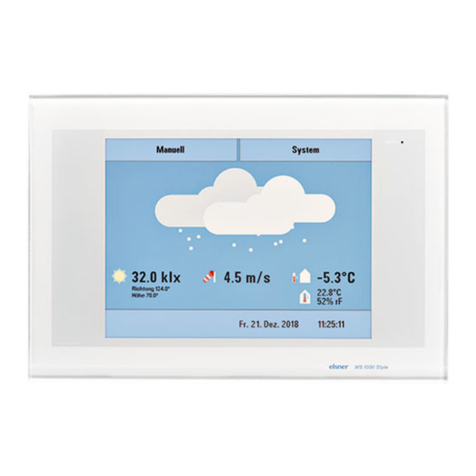
elsner elektronik
elsner elektronik WS1000 Style Brief Instruction
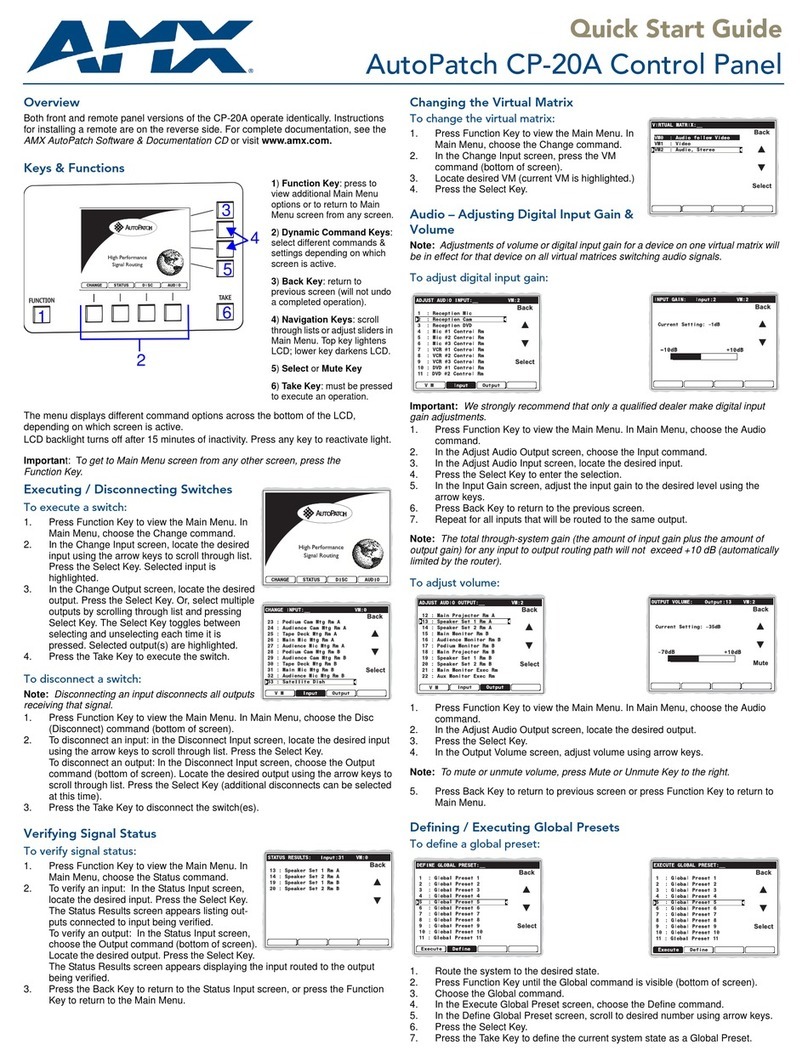
AMX
AMX AutoPatch CP-20A quick start guide
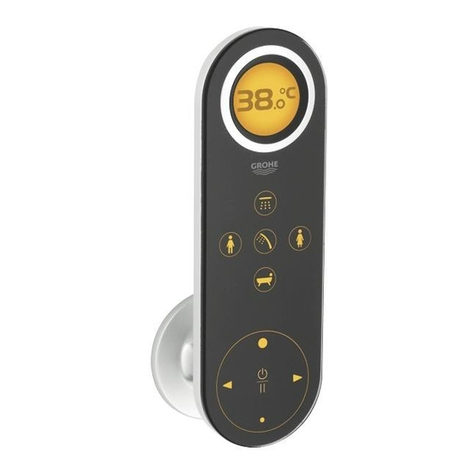
Grohe
Grohe Ondus 36050 manual

Logitech
Logitech HEAVY EQUIPMENT SIDE PANEL user guide
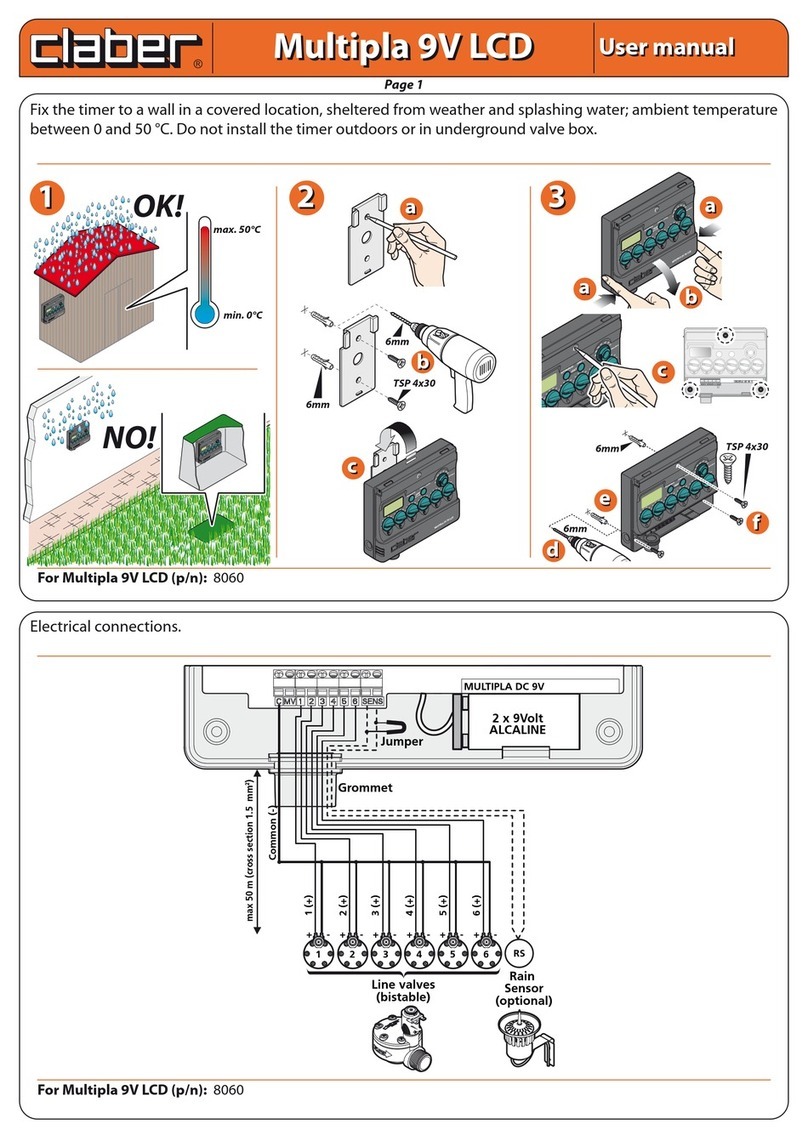
claber
claber Multipla DC 9 V LCD user manual
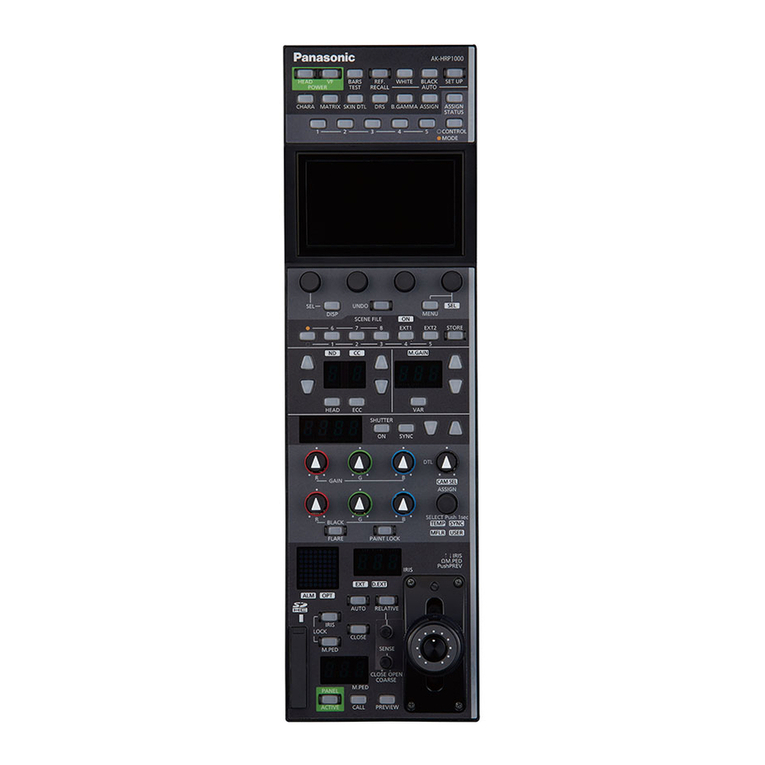
Panasonic
Panasonic AK-HRP1000G operating guide

SALUPO
SALUPO SA623 Series Instruction and installation manual
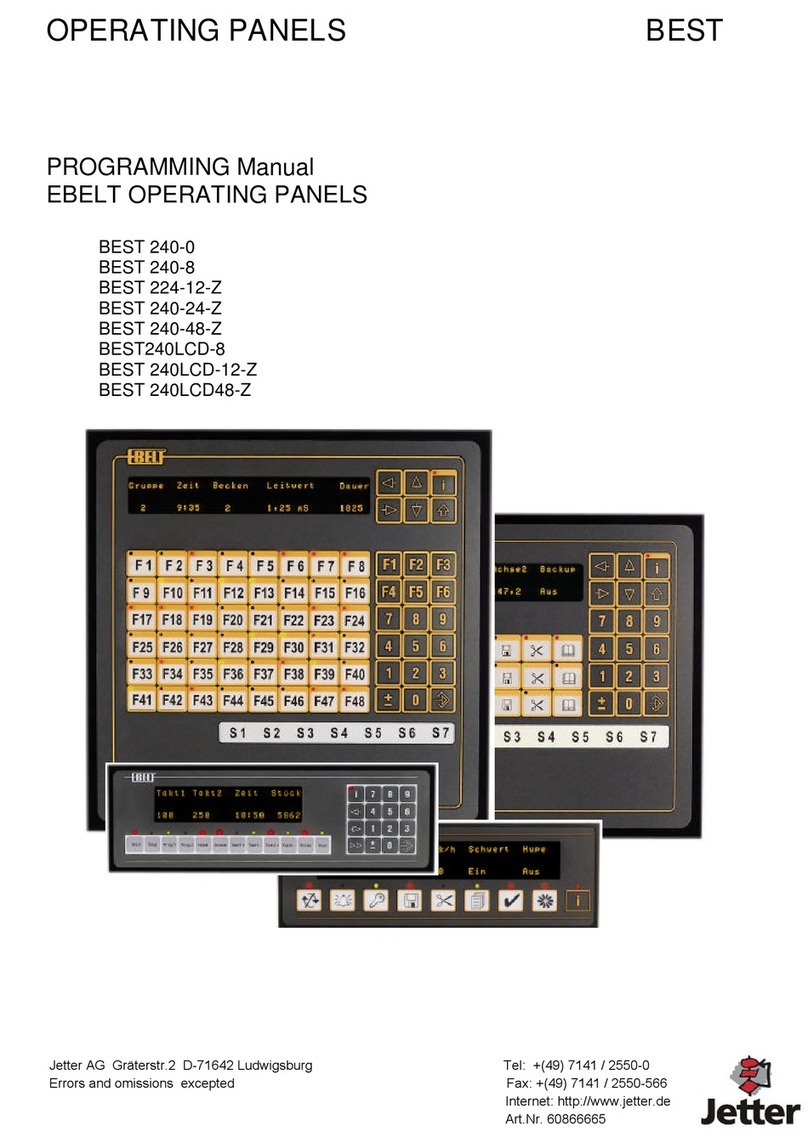
Jetter
Jetter EBELT BEST Series Programming manual

Intermatic
Intermatic PE25300 Installation, operation & service manual
